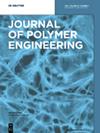从低浓度溶液中电喷涂低毒聚己内酯微球
IF 1.7
4区 工程技术
Q4 POLYMER SCIENCE
引用次数: 0
摘要
摘要:本工作描述了利用极低浓度溶液成功地可调生产聚己内酯(PCL)微球。用不同的溶剂(二氯甲烷(DCM)和氯仿(CHL))制备PCL溶液(1、3和5 w/v%),并在不同的距离(5、10和15 cm)上进行电喷涂。PCL溶液的溶解度和黏度与聚合物浓度呈正相关,说明PCL- dcm溶液的溶解度较高,而PCL- chl溶液的黏度较高。光学显微镜(OM)和场发射扫描电镜(FE-SEM)显示,PCL-DCM制备的微球尺寸和孔径比PCL-CHL微球更小、更均匀。线性回归分析表明,PCL浓度的溶解度和粘度对微球尺寸的影响大于孔径。毒性结果表明,PCL-CHL和PCL-DCM在斑马鱼胚胎中具有良好的耐受性,能够遵循正常的生长途径,因此可以认为是安全的。本文章由计算机程序翻译,如有差异,请以英文原文为准。
Electrosprayed low toxicity polycaprolactone microspheres from low concentration solutions
Abstract This work describes the successful tunable production of polycaprolactone (PCL) microspheres using very low-concentration solutions. The PCL solutions (1, 3, and 5 w/v%) were prepared with different solvents (dichloromethane (DCM) and chloroform (CHL)) and electrosprayed at different distances (5, 10, and 15 cm). The solubility and viscosity of PCL solutions were in accordance with the polymer concentrations, demonstrating PCL-DCM gave a higher solubility of PCL, but PCL-CHL solutions had a higher viscosity. Optical microscopy (OM) and field emission-scanning electron microscopy (FE-SEM) revealed that the PCL-DCM preparations produced a smaller and more uniform microsphere size and pore size compared to PCL-CHL microspheres. The linear regression analysis showed that the solubility and viscosity of PCL concentration influence the size of microspheres more greatly than the pore size. The toxicity results indicated that PCL-CHL and PCL-DCM are well-tolerated by zebrafish embryos that were able to follow a normal growth pathway and can thus be deemed safe.
求助全文
通过发布文献求助,成功后即可免费获取论文全文。
去求助
来源期刊

Journal of Polymer Engineering
工程技术-高分子科学
CiteScore
3.20
自引率
5.00%
发文量
95
审稿时长
2.5 months
期刊介绍:
Journal of Polymer Engineering publishes reviews, original basic and applied research contributions as well as recent technological developments in polymer engineering. Polymer engineering is a strongly interdisciplinary field and papers published by the journal may span areas such as polymer physics, polymer processing and engineering of polymer-based materials and their applications. The editors and the publisher are committed to high quality standards and rapid handling of the peer review and publication processes.
 求助内容:
求助内容: 应助结果提醒方式:
应助结果提醒方式:


